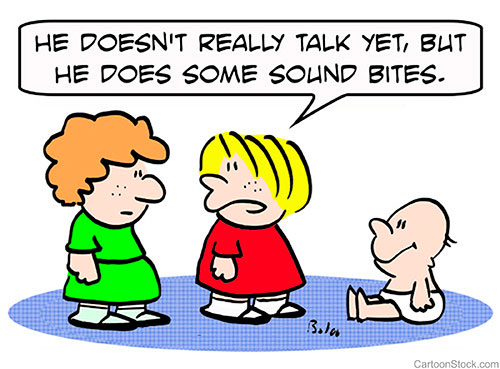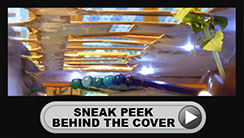
Photo credit: CartoonStock
By Claire Doole, Claire Doole Communications
As a journalist, I knew immediately what sound bites I would use in my radio or television reports for the BBC. They were the couple of sentences that made for lively copy and were instantly memorable.
What I may not have grasped in my rush to hit my deadline was that the speaker or in some cases their communications teams had carefully crafted that sound bite with the express intent that I would use it. They knew that sound bites serve as a perfect delivery vehicle for their key messages.
Speakers, who want their messages to be memorable, ensure that they plant at least one sound bite in their media interviews and speeches to illustrate their central idea. They then use them again in their Tweets as 280 characters are the equivalent of around 50 words or 17 seconds of speech.
The art of rhetoric
Although we talk about today's sound bite culture, it dates back thousands of years to the time of the ancient Greeks and Romans, who developed the art of rhetoric.
Some of the most powerful sound bites come from the rhetorical devices that they mastered.
Rule of three
When we make points in threes this gives the impression of finality. American presidents down the centuries have been using this technique in their speeches. Abraham Lincoln's "Government of the people, by the people for the people" is one of the most memorable.
I was particularly struck by the power of this device when Beatrice Fihn, the head of the Nobel Peace Prize winning International Campaign to Abolish Nuclear Weapons sent this message to U.S. President Donald Trump and North Korean leader Kim Jong Un:
“Nuclear weapons are illegal. Threatening to use nuclear weapons is illegal. Having nuclear weapons, possessing nuclear weapons, developing nuclear weapons, is illegal, and they need to stop.”
Contrast
This highlights the senses, and forces the audience to pick sides. Think of George Bush's remarks to Congress after the September 11th attacks in 2001.
"Every nation, in every region, now has a decision to make. Either you are with us, or you are with the terrorists."
It is often used at the beginning of speeches as in Barack Obama's inaugural in January 2009 when he told crowds "we have chosen hope over fear, unity of purpose over discord."
Images, similes and metaphors
These allow the speaker to strike the message deep into the audience's hearts. Some of history's most famous speeches have focussed around a single image such as Nelson Mandela's "road to freedom" and Margaret Thatcher's "the lady's not for turning."
It is a technique that is guaranteed to get media coverage. When Beatrice Fihn spoke to the world's media after winning the Nobel Peace Prize last year, her remarks that "mankind's destruction caused by nuclear war is just one impulsive tantrum away" made headlines around the world as the US and North Korea exchanged threats over the nation's nuclear tests.
Great speakers make sure they use imagery, which is meaningful for their audience. Those involved in healthcare often see it in terms of war, using metaphors such as "fighting infection" or "combating malaria" or "doctors on the frontline". Recently the head of the International Committee of the Red Cross operations in the Middle East, Robert Mardini, was much quoted when he said that Yemen "had been drip-fed for two years. It needs intensive care."
Use with care
A note of caution though, the images must be fresh and not have become clichés. To quote George Orwell, "never use a metaphor, simile or other figure of speech which you are used to seeing in print."
Similarly any speech or interview must be more than just a collection of sound bites. They must be substantive, containing something new and reinforcing your line of argument.
So, if you want to make sure the media quotes you and the public remember you, take time and craft a sound bite that captures the essence of your message. After all, if people can remember what you say, they're more likely to think about what you said and then act upon it.
Author's bio
 Claire is a former BBC correspondent and international spokeswoman who is passionate about helping people communicate with confidence. Since 2006, she has successfully trained hundreds of professionals in the art of presenting and public speaking, talking to the media, managing communications in a crisis, and writing for the web. In addition, she has coached C-level executives and public figures to give powerful TEDx and TED style talks in Europe and the Middle East. A Swiss and UK national, Claire trains and coaches in French and English.
Claire is a former BBC correspondent and international spokeswoman who is passionate about helping people communicate with confidence. Since 2006, she has successfully trained hundreds of professionals in the art of presenting and public speaking, talking to the media, managing communications in a crisis, and writing for the web. In addition, she has coached C-level executives and public figures to give powerful TEDx and TED style talks in Europe and the Middle East. A Swiss and UK national, Claire trains and coaches in French and English.
Claire is also a highly experienced moderator having facilitated panel discussions with government ministers, NGO activists, humanitarians and human rights specialists at major events.








